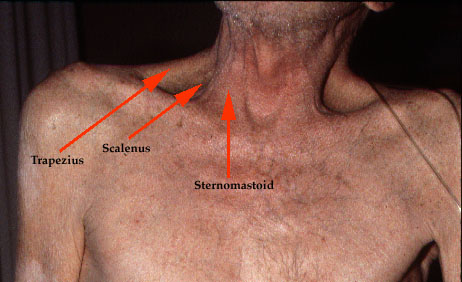WRONG!
The breath is an element that is often overlooked in most fitness programs. When most people think of the breath as it pertains to fitness, they think about timing. Breathe in during the eccentric, breathe out during the concentric etc.. While this is not incorrect, it is a very small piece of the picture.
I have come across several individuals with shoulder, hip, knee, and low back problems over the years. In the past, I would run them through the necessary steps on intake such as movement screening and static posture evaluation. Then prescribe some correctives and design a program to address dysfunction and keep them healthy. The problem was, all this corrective intervention did not always work and it left me wondering why. Part of it was a lack of adherence on the client's part (not performing corrective homework), but the other part was that I was missing a HUGE piece of the puzzle.
Breathing.
Before I go further, let me give a brief, extremely watered down, anatomy lesson. Try not to fall asleep on me. There are two areas of the body that are responsible for respiration:
1. The Diaphragm
The diaphragm has two primary functions:
1. Respiration
2. Stability
Let's look at respiration first:
The chief muscle responsible for respiration is the diaphragm. Ideally, when you breathe in the diaphragm contracts and presses downward and outward on the abdominal cavity (see image left). This creates Intra-Abdominal Pressure (IAP) and provides stability through the trunk. Powerlifters and Olympic Weightlifters are experts at creating this IAP and using it to lift heavy things.
When you breathe out, the diaphragm expands and the rib cage should depress, allowing you to expel all of your air (image right).
Now let's look at stability:
The diaphragm has several attachment points around the abdomen, which imply its role in stabilization of the trunk.
As mentioned above, the role the diaphragm plays in stability is creating inter-abdominal pressure. Picture blowing up a balloon. Now press down on both sides of the balloon. What happens? The pressure inside the balloon is increased dramatically. This is what occurs when you take a proper breath. The pressure created by you pressing down with your hands (diaphragm) creates more stability through the abdominal cavity (balloon). When the trunk is stable, the rest of your body will be too.
In an ideal breathing pattern, the diaphragm performs both respiration and stabilization simultaneously. Given the choice between the two, your body will always choose respiration over stabilization because you need to breathe to live. If the diaphragm does not function properly, stability will become compromised because the body will look elsewhere to get it, which brings me to the next area.
2. Accessory Muscles
Accessory muscles for respiration reside in the shoulder complex, neck, hip flexors, and around the spine. If the diaphragm does not function properly, these muscles will do the bulk of the work. Notice how pronounced these muscles are on the individual in the image above. A telltale sign of a poor breathing strategy. Some people look like this every time they take a breath! Shoulder problems and neck pain a common in individuals with the above breathing strategy.
When these accessory muscles are overactive, they get short and stiff, wreaking havoc on your posture and movement. Considering the average human being takes around 22,000 breaths every day, you might begin to see why an accessory breathing strategy can lead to problems.
When one relies on a hip flexor and paraspinal accessory breathing strategy, their posture might look something like this:
Notice how high this individual's ribs are and how much his butt sticks out. There is a pretty good chance he is hanging on his hip flexors and low back muscles, relying on them to breathe. Individuals like this are also in a constant state of inhalation. Their diaphragm is constantly stretched and they are unable to expel all of their air. If you can't get a good breath out, you sure as hell aren't going to get a good breath in. Low back and knee pain are pretty common in individuals like this. If you look like this during standing and most movements (deadlifts and push ups for example), no amount of stretching will help you. You must correct your breathing strategy first.
Here are a few other signs you might have a sucky breathing pattern:
- Poor Posture
- Shoulder Pain
- Low Back Pain
- Knee Pain
- Headaches
- Neck Pain
- Poor Trunk Stability
- Increased Respiratory Rate
- Anxiety
- High Blood Pressure
- Frequent Dizziness (especially during exercise)
- Red Face During Exercise
- Facial Numbness or Tingling During Exercise
- Frequent Yawning or Heavy Sighing During Exercise
Next time I'll go into what a good breathing strategy looks like, as well as what you can do to improve your breathing pattern.




No comments:
Post a Comment